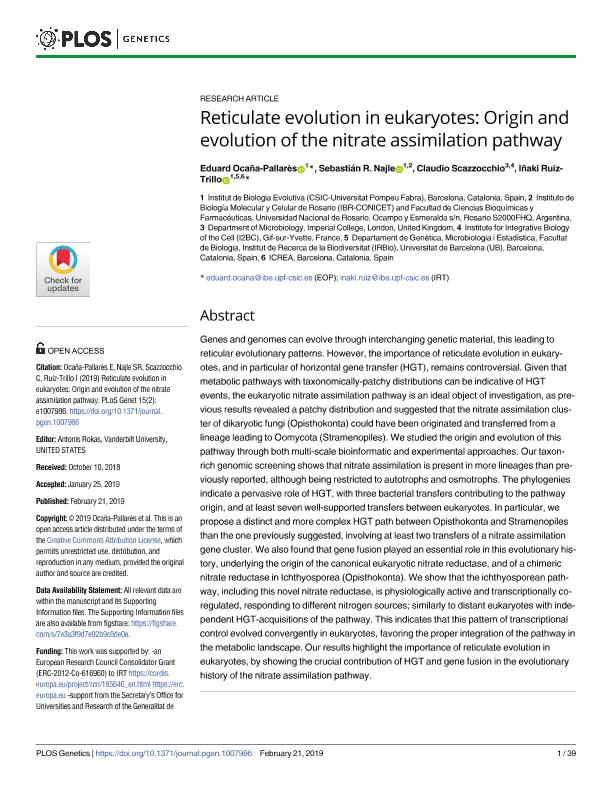Mostrar el registro sencillo del ítem
dc.contributor.author
Ocaña Pallarès, Eduard
dc.contributor.author
Najle, Sebastián Rodrigo

dc.contributor.author
Scazzocchio, Claudio
dc.contributor.author
Ruiz Trillo, Iñaki
dc.date.available
2022-02-07T18:45:28Z
dc.date.issued
2019-02
dc.identifier.citation
Ocaña Pallarès, Eduard; Najle, Sebastián Rodrigo; Scazzocchio, Claudio; Ruiz Trillo, Iñaki; Reticulate evolution in eukaryotes: Origin and evolution of the nitrate assimilation pathway; Public Library of Science; Plos Genetics; 15; 2; 2-2019; 1-39
dc.identifier.uri
http://hdl.handle.net/11336/151486
dc.description.abstract
Genes and genomes can evolve through interchanging genetic material, this leading to reticular evolutionary patterns. However, the importance of reticulate evolution in eukaryotes, and in particular of horizontal gene transfer (HGT), remains controversial. Given that metabolic pathways with taxonomically-patchy distributions can be indicative of HGT events, the eukaryotic nitrate assimilation pathway is an ideal object of investigation, as previous results revealed a patchy distribution and suggested that the nitrate assimilation cluster of dikaryotic fungi (Opisthokonta) could have been originated and transferred from a lineage leading to Oomycota (Stramenopiles). We studied the origin and evolution of this pathway through both multi-scale bioinformatic and experimental approaches. Our taxonrich genomic screening shows that nitrate assimilation is present in more lineages than previously reported, although being restricted to autotrophs and osmotrophs. The phylogenies indicate a pervasive role of HGT, with three bacterial transfers contributing to the pathway origin, and at least seven well-supported transfers between eukaryotes. In particular, we propose a distinct and more complex HGT path between Opisthokonta and Stramenopiles than the one previously suggested, involving at least two transfers of a nitrate assimilation gene cluster. We also found that gene fusion played an essential role in this evolutionary history, underlying the origin of the canonical eukaryotic nitrate reductase, and of a chimeric nitrate reductase in Ichthyosporea (Opisthokonta). We show that the ichthyosporean pathway, including this novel nitrate reductase, is physiologically active and transcriptionally coregulated, responding to different nitrogen sources; similarly to distant eukaryotes with independent HGT-acquisitions of the pathway. This indicates that this pattern of transcriptional control evolved convergently in eukaryotes, favoring the proper integration of the pathway in the metabolic landscape. Our results highlight the importance of reticulate evolution in eukaryotes, by showing the crucial contribution of HGT and gene fusion in the evolutionary history of the nitrate assimilation pathway.
dc.format
application/pdf
dc.language.iso
eng
dc.publisher
Public Library of Science

dc.rights
info:eu-repo/semantics/openAccess
dc.rights.uri
https://creativecommons.org/licenses/by/2.5/ar/
dc.subject
EUKARYOTIC EVOLUTION
dc.subject
HORIZONTAL GENE TRANSFER
dc.subject
NITRATE ASSIMILATION CLUSTER
dc.subject
ICHTHYSOPOREA
dc.subject.classification
Biología

dc.subject.classification
Ciencias Biológicas

dc.subject.classification
CIENCIAS NATURALES Y EXACTAS

dc.title
Reticulate evolution in eukaryotes: Origin and evolution of the nitrate assimilation pathway
dc.type
info:eu-repo/semantics/article
dc.type
info:ar-repo/semantics/artículo
dc.type
info:eu-repo/semantics/publishedVersion
dc.date.updated
2020-11-25T18:00:33Z
dc.identifier.eissn
1553-7404
dc.journal.volume
15
dc.journal.number
2
dc.journal.pagination
1-39
dc.journal.pais
Estados Unidos

dc.journal.ciudad
San Francisco
dc.description.fil
Fil: Ocaña Pallarès, Eduard. Universitat Pompeu Fabra; España. Consejo Superior de Investigaciones Científicas; España
dc.description.fil
Fil: Najle, Sebastián Rodrigo. Consejo Nacional de Investigaciones Científicas y Técnicas. Centro Científico Tecnológico Conicet - Rosario. Instituto de Biología Molecular y Celular de Rosario. Universidad Nacional de Rosario. Facultad de Ciencias Bioquímicas y Farmacéuticas. Instituto de Biología Molecular y Celular de Rosario; Argentina. Universitat Pompeu Fabra; España. Consejo Superior de Investigaciones Científicas; España
dc.description.fil
Fil: Scazzocchio, Claudio. Imperial College London; Reino Unido. Institute for Integrative Biology of the Cell; Francia
dc.description.fil
Fil: Ruiz Trillo, Iñaki. Universitat Pompeu Fabra; España. Consejo Superior de Investigaciones Científicas; España. Universidad de Barcelona; España. International Computer Room Experts Association; España
dc.journal.title
Plos Genetics

dc.relation.alternativeid
info:eu-repo/semantics/altIdentifier/url/http://dx.plos.org/10.1371/journal.pgen.1007986
dc.relation.alternativeid
info:eu-repo/semantics/altIdentifier/doi/http://dx.doi.org/10.1371/journal.pgen.1007986
Archivos asociados
